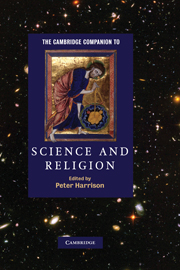Book contents
- Frontmatter
- Introduction
- Part I Historical interactions
- Part II Religion and contemporary science
- 6 Scientific creationism and intelligent design
- 7 Evolution and the inevitability of intelligent life
- 8 God, physics and the Big Bang
- 9 Psychology and theology
- 10 Science, bioethics and religion
- Part III Philosophical perspectives
- A guide to further reading
- Index
6 - Scientific creationism and intelligent design
from Part II - Religion and contemporary science
Published online by Cambridge University Press: 28 July 2010
- Frontmatter
- Introduction
- Part I Historical interactions
- Part II Religion and contemporary science
- 6 Scientific creationism and intelligent design
- 7 Evolution and the inevitability of intelligent life
- 8 God, physics and the Big Bang
- 9 Psychology and theology
- 10 Science, bioethics and religion
- Part III Philosophical perspectives
- A guide to further reading
- Index
Summary
For the past century and a half no issue has dominated discussions of science and religion more than evolution. Indeed, many people see the creation-evolution debates as the central issue in the continuing controversy. And for good reason. More than a century after the scientific community had embraced organic evolution, many laypersons continued to scorn the notion of common descent. In the United States, where polls since the early 1980s have shown a steady 44-47 per cent of Americans subscribing to the statement that 'God created human beings pretty much in their present form at one time within the last 10,000 years or so', nearly two-thirds (65.5 per cent), including 63 per cent of college graduates, according to a 2005 Gallup poll, regarded creationism as definitely or probably true. As we shall see, such ideas have been spreading around the world. /Creation and Creationism / In 1929 an obscure biology teacher at a small church college in northern California self-published a book entitled Back to Creationism. This brief work, appearing just as the American anti-evolution movement of the 1920s was winding down, attracted little attention.
- Type
- Chapter
- Information
- The Cambridge Companion to Science and Religion , pp. 127 - 147Publisher: Cambridge University PressPrint publication year: 2010
- 4
- Cited by



